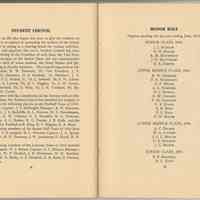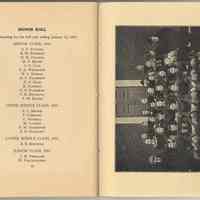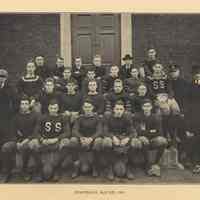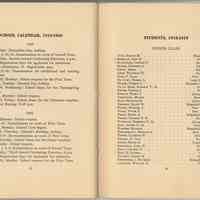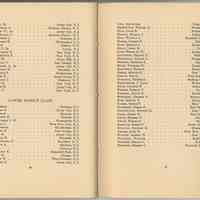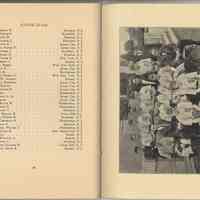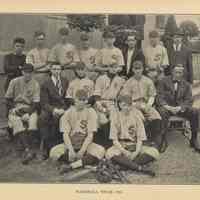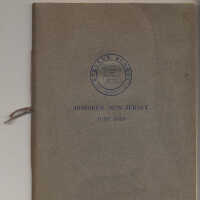Collections Item Detail
Catalog / yearbook: Stevens School. June, 1919. 6th St. at Park Ave., Hoboken, N.J.
2011.001.0003
2011.001
Purchase
Purchase
Museum Collections.
1918 - 1919
Date(s) Created: 1919 Date(s): 1918-1919
Good
Notes: Archives 2011.001.0003 STEVENS SCHOOL JUNE, 1919 SIXTH STREET AT PARK AVENUE HOBOKEN, NEW JERSEY CONTENTS ADMISSION 10 ADVISORY BOARD 4 ALUMNI ASSOCIATION 33 ATHLETICS 36 CALENDAR 42 CERTIFICATES 30 CLASS ORGANIZATIONS 41 COMMENCEMENT 32 CURRICULUM 13 DESCRIPTION OF SUBJECTS 14 DIPLOMAS 30 EXAMINATIONS 31 EXCUSES 26 FACULTY 5, 22 HOME WORK 30 HONOR ROLLS 39 HONORS, SCHOLARSHIPS AND PRIZES 34 LOCATION AND BUILDING 9 MANAGEMENT 8 PREPARATION FOR COLLEGE 28 RATES OF TUITION 12 REPORTS 31 SESSIONS .25 STUDENT ACTIVITIES 36 STUDENT COUNCIL 38 STUDENTS 43 ADVISORY BOARD ALEXANDER C. HUMPHREYS, ME., Sc.D., LL.D. President, Stevens Institute of Technology FRANCIS J. POND, Ph.D. Professor of Chemistry and Director of the Morton Memorial Laboratory, Stevens Institute of Technology FREDERICK L. PRYOR, M.E. Professor of Mechanical Engineering, Superintendent of Build- ings and Grounds, Stevens Institute of Technology FACULTY B. F. CARTER, A.M., PRINCETON Head Master FRANK J. DAVEY, M.D., LONG ISLAND MATHEMATICS AND SENIOR ENGLISH ERWIN W. GROVE, PH.B., LAFAYETTE SCIENCE AND HISTORY JOHN W. McCORMACK, A.M., MIDDLEBURY SCIENCE AND FREE HAND DRAWING HENRY P. SCRATCHLEY, A.M., B.D., GRISWOLD MATHEMATICS JEROME L. ICERBECK, B.S., A.M., COLUMBIA ENGLISH AND HISTORY DONALD W. HENRY, A.B., LAFAYETTE LANGUAGES LEON E. DANIELS, A.B., UNIVERSITY OF VERMONT LANGUAGES JOSEPH F. SULLIVAN, BUFFALO STATE NORMAL MATHEMATICS AND SCIENCE 5 JOHN R. IRWIN, PH.B., LAFAYETTE MATHEMATICS AND ENGLISH SAMUEL H. LOTT, M.E., STEVENS INSTITUTE Assistant Professor, Stevens Institute MECHANICAL DRAWING LOUELLA J. BENSON Secretary 6 STEVENS SCHOOL STEVENS SCHOOL, founded in 1870 by the Trustees of Stevens Institute of Technology, has had a long and successful existence. It was one of the first schools in the country to offer satisfactory training in Mathematics and Science, as it introduced into its curriculum at the beginning several novel features, one of which was the teaching of two mathematical subjects during the same year. For several years past, Stevens Institute had grown so rapidly in numbers on account of admission by certificate as well as by examination, that part of the school building on River Street had been occupied by the Institute classes and, in October, 1916, the Trustees decided, with regret, that they would need the whole building as a recitation hall, the change to take effect in September, 1917. At once, Mr. B. F. Carter and Mr. L. G. Saunders, for many years members of the Faculty, started to make arrangements to continue the School in a new location. They were fortunate in securing the former Hoboken High School building, and Stevens School opened on September 17,1917, for the first year under the new management. The Head Masters enjoyed the co-operation of the Trustees of the Institute and the assistance of many of the former excellent Faculty. Co-operation of Stevens Institute The Trustees wished the close relations between the Institute and School to continue and Dr. Alexander C. Humphreys, President of the Faculty and Board of Trustees, sent to patrons a letter embodying their views, in which he says: "Our co-operation will take definite form as follows: 1. The School can continue to be known as Stevens School. 2. An advisory board will be appointed from the Institute Faculty, to exercise an oversight of the administration of the School at least for the next three years, that is, until the students now in the School have had the opportunity to graduate. 3. At least for the same period, one free scholarship in the Institute each year will be, as before, open to competition. 4. Certain parts of the equipment of the School, including the physical and chemical apparatus, will be placed at the disposal of the new organization, so long as the School is conducted to meet our views. 5. The athletic trophies of our School shall be placed in the keeping of the new Stevens School under the same conditions as stipulated in No. 4. "With these facts presented, the Trustees extend to the new enterprise their best wishes for the greatest measure of success with the hope and belief that it will maintain the traditions and high educational standards of the old School, and that a close and friendly relation will be cultivated and maintained between the new School and the Institute. "Finally, on behalf of the Trustees, I express the hope that the students now enrolled in the School will enroll as members of the new School." Since June, 1918, the School has been under the sole direction of the Head Master, as Mr. Saunders resigned his position at that time. LOCATION AND BUILDING Location The School occupies the former Hoboken High School building, called the Martha Institute, at the corner of Sixth Street and Park Avenue. It is easily accessible from all points in metropolitan New York and New Jersey, as it is only thirteen minutes' walk from the Hudson Tubes Ter- minal, the Lackawanna Terminal, the Barclay, Christopher and Fourteenth Street ferries. In addition, it is but three short blocks from the Washington Street trolley line, and one block from the Willow Avenue line, to both of which transfers may be obtained from the Jersey City, Weehawken, West Hoboken, and Union Hill lines and all through lines entering Hoboken. Building The large brick building is well adapted for school purposes, situated as it is on a corner, with light and air on all four sides and on streets paved with asphalt or wood blocks. Every classroom is well ventilated and lighted, not only by large windows, but also by electric light for dark and stormy days. The whole building is thoroughly renovated and put in the best of condition, the heating plant overhauled and additional radiation installed. There are five fire exits and a wide fire escape with regular steps, leading from the top floor. On the ground floor is a large assembly hall where the School gathers for singing and public speaking, for addresses by men of influence in various lines, for reports of athletic activities and for meetings that tend to develop esprit de corps. In this way, each student realizes that he is an integral part of the school, while section and class feeling merge into school loyalty. On the floors above the hall are nine classrooms, two large lab- oratories, a reading room, office, and lunchrooms. 9 ASSEMBLY HALL REQUIREMENTS FOR ADMISSION Applicants for admission to the Junior Class must have com- pleted the courses of study in the grammar grades. They are admitted without examination on presentation of a diploma. Applicants for admission to the higher classes must take exami- nations on the work of the classes below the one they wish to enter, or present certificates from the schools previously attended, stating that they have passed satisfactory examinations in the subjects mentioned. Such certificates are essential also in giving credit for admission to college. It is important that application be made as early as possible. As a personal interview is much more satisfactory than a letter, the applicant is requested to see the Head Master in person, when- ever convenient. It is hoped, also, that parents will accompany their sons on the first visit to the School. Students, if properly qualified, are received at any time, but the advantages of the boys who enter at the beginning of the school year or of the second term are obvious. It is noticed, also, that those who enter early in the school course are better prepared for the higher classes, both in mental training and in the completeness of their scholastic preparation, than those who enter the School later. Registration days will be as follows: June 4 to Bags June 30; August 25 to September 12, 1919. Office hours, 9 to 4. Students should bring with them, if possible at the first inter- view, credentials from other schools attended, in order that their courses may be arranged with an exact knowledge of what they need. 10 Examinations for admission will be held on September 11 and 12, 1919. Assignment to Classes On account of the flexibility of the system of instruction, it is possible for a student to take different subjects with several classes. Because of this, the student's state of preparation is the guide of assignments to classes: in each subject he is placed in the class for which he is prepared. This is especially true of the languages-Latin, French, Spanish, or German-in which the degree of advancement fre- quently bears no relation to the preparation of the student in Science or Mathematics. Assignments to classes are provisional: if at any time the student's interests demand a readjustment of schedule, this will be made, in order that the best results may be secured. 11 RATES OF TUITION The tuition for the two lower classes is $150 per annum; for the Upper Middle and Senior years, $300 per annum. These amounts are payable in two equal installments, not later than two weeks after the beginning of each term. Students enter- ing at any time within six weeks after the beginning of the term are charged full tuition. No deductions are made for absence ex- cept on account of illness and then only when the absence has con- tinued for half a term. In such cases the loss is divided equally between the School and the parents. No refund is allowed for pupils withdrawing from the School after the first four weeks of a term for other reasons than sickness. Each student is required, upon admission, to make a deposit of $5 to apply on the purchase of text-books and supplies, unex- pended balances to be returned upon graduation or the withdrawal of the student. In order to defray, partially, the cost of the maintenance of athletics, an annual athletic fee of $5 is charged each student. 12 CURRICULUM JUNIOR CLASS Both Terms Algebra-5 periods; Physiography-5 periods; English-5 periods; Foreign Language-5 periods; Free Hand Drawing-1 period. LOWER MIDDLE CLASS Both Terms Algebra-3 periods; Biology-4 periods; English-4 periods; English History-4 periods; Foreign Language-o periods; Free Hand Drawing-1 period. UPPER MIDDLE CLASS Both Terms Plane Geometry-5 periods; Chemistry-4 periods; Chemical Laboratory-2 periods; English-d: periods; United States His- tory and Civics-4 periods; Foreign Language-5 periods. SENIOR CLASS First Term Intermediate Algebra-4 periods; Solid Geometry or Plane Trigonometry-5 periods; Physics-4 periods; Physical Labora- tory-2 periods; English-4 periods; Foreign Language-5 pe- riods ; Mechanical Drawing-1 period. Second Term Intermediate Algebra-4 periods; Higher Algebra (for ad- vanced students)-4 periods; Plane Trigonometry or Solid Geom- etry-5 periods; Physics-4 periods; Physical Laboratory-2 periods; English-4 periods; Foreign Language-5 periods; Mechanical Drawing-1 period. 13 DESCRIPTION OF SUBJECTS ENGLISH The study of English in the School has two main objects: (1) command of correct, clear English, spoken and written; (2) ability to read with intelligence and appreciation. The first object requires instruction in grammar and composi- tion. During the first two years of the course, there is a gram- matical review based on Lewis and Hosic's Practical English. At the same time the principles of composition are taken up and applied in oral and written exercises. During the last two years, Brooks' Composition is used as a text-book to teach more ad- vanced principles in connection with themes and essays. Spelling is taught not only in English but also in all other courses. For this purpose, special lists of words for each subject have been prepared by the Head Master. A Word Book is also used. The second object is sought by reading classics selected from the list issued by the Committee on College Entrance Require- ments and, in the Senior year, by intensive study of several books named for admission to college, with greater stress laid on style, the meaning of words and phrases, and the close study of allusions. The following books have been read, either wholly or in part, during 1918-1919. In the Junior Class: Treasure Island, Short Stories, Pope's The Odyssey, Midsummer-Night's Dream. In the Lower Middle Class: Oregon Trail, Julius Caesar, Idylls of the King, Silas Marner. 14 In the Upper Middle Class: Clive, Twelfth Night, Deserted Vil- lage, Gray's Poems, World War Aims and Ideals. In the Senior Class: Macbeth, Milton's Minor Poems, Burke on Conciliation with America, Macaulay's Life of Johnson. Supplementary reading is required of all students in the three lower classes. Printed lists are given to the boys from which they select books on the war, poetry, drama, fiction or non-fiction, reporting to the Master on each one read or writing out an outline to be corrected. Assembly declamation is also a part of the English course. MATHEMATICS Algebra A majority of the students of Stevens School are preparing to take engineering courses in college. For such pupils a thorough training in Algebra is absolutely essen- tial. The workman must be thoroughly conversant with his tools and the pupil is never allowed to forget that his knowledge of Algebra is a tool which he must use with readiness and precision in his college mathematics. The time devoted to this subject is much greater than in the majority of schools. Throughout the course two ideas are especially emphasized- application of principles and accuracy of workmanship. The instructor leads the pupil to discover the principles inductively. After a principle is explained, many problems are solved in order that the pupil may learn to apply the principle. Accuracy is se- cured by requiring checking of results. The student is led to see that the benefit in the correct solution of a problem lies in the fact that he has consciously and correctly applied one or more principles. He is required to tell, not only how he solved it, but why he solved it as he did, and, in addition, to prove that his result is accurate by an adequate check. Many practical problems 15 are thus solved so that by frequent repetition what has once been learned will not be forgotten. The result of the course, therefore, is to fix the principles in the student's mind, to teach him when and how to apply these principles, and to make him confident of the accuracy of his work through the use of checks. Advanced Algebra is taught in the second term of the Senior Class for those who need it for college entrance and for others who, although the subject is not required, yet wish to be more than ordinarily well prepared in Algebra. The text-books used have been the First Course in Algebra by Hawkes, Luby, and Touton, Complete Course in Algebra, by the same authors, and Higher Algebra by Hawkes. Geometry In the teaching of Geometry, the aim of the instruc- tion is to develop and strengthen the power to originate and carry on a logical train of thought. To this end many original exercises are employed and frequent carefully graded tests given. Plane Geometry is given five times a week throughout the Upper Middle year. It is preceded by a short course in geometri- cal concepts, taught at the end of the Lower Middle year in con- nection with Algebra. Solid Geometry is taught five periods per week throughout either term of the Senior year. The text- book is Schultze and Sevenoak's Plane and Solid Geometry. Trignonometry A knowledge of Plane Trigonometry is of prime importance to the boy who contemplates an en- gineering course. This is the determining factor in the selection of topics to be treated and in the relative amount of time as- signed to each. Much drill work is given upon those parts of the subject which should be remembered for use in college courses. This subject is given five periods a week during either term 12 of the Senior year. The text-book used has been Granville's Plane Trigonometry. SCIENCE An important feature of the school course is the introduction of some branch of Science into the work of each year. Physiography In the Junior year, Physiography is studied with the purpose of arousing an interest in natural ob- jects and the common things of life. Even more important, it is believed, than the information gained is the formation of the habit of close observation. Besides the study of Dryer's Physical Geography, Parts I and II, laboratory experiments are made to de- termine the latitude of the city, the weather reports are worked out in a practical manner, and government maps of New York, New Jersey, Niagara Falls, Mt. Shasta, the Mississippi Delta and other places are studied with a view to accurate map reading. Biology In the Lower Middle Class, Biology is taught with Smallwood's Practical Biology as a text. The idea is kept constantly in mind that a boy should understand the rela- tion of plants and animals to one another and to man. The eco- nomic value of plants and animals is studied. Special emphasis is placed upon personal hygiene and public sanitation as well as upon the use of protective medicine. Laboratory exercises are given in order to fix firmly in the student's mind the subject under consideration. Lectures on special subjects are a part of the course. In many cases, topics, assigned to individual students, are made the basis of class discussion. Chemistry The Science for the third year is Chemistry, the course in which includes the study of First Prin- ciples of Chemistry, Revised, by Brownlee and Others, for four periods a week throughout the year. Detailed knowledge of the 17 CHEMICAL LABORATORY more important elements and their compounds is required. Indi- vidual laboratory work covering about thirty-six experiments is carried on for two periods a week and a notebook, written up in the room by the student himself, is certified by the Master. Physics Physics is taught during the Senior year. Carhart and Chute's First Principles of Physics is the text- book used for four hours a week. Many numerical problems are assigned for both class and home work. The two laboratory periods each week give all the familiarity with the methods of making physical measurements and recording results that can be expected in a preparatory course. Each student keeps a record of his own experiments in a notebook, which is certified by the Master. MODERN LANGUAGES The courses in French, Spanish, and German follow the method outlined in the Report of the Committee of Twelve on Modern Languages. The aim of the instruction is to make it possible for the student to pronounce correctly, to translate at sight easy prose or poetry, to put into the language studied simple English sentences based on everyday life or upon the text read and to answer questions on the essential points of grammar and syntax. In order to secure this, drill in pronunciation is begun with the first lesson and is a constant accompaniment of the instruction. Systematic efforts are made to build up a vocabulary of common words and phrases, in order to provide a basis for sight transla- tion. A thorough drill in the rudiments of grammar and in verb forms is carried on throughout all the years of the course. That the new aural tests of the colleges may be met, special attention is paid to dictation and to the reproduction in English of unprepared passages read aloud by the Master. 18 The text-books vary somewhat from year to year but generally include some scientific reading as well as poetry, drama, and fiction. German will still be taught in the upper classes in order that those students who need the points for admission to college will not lose the work already completed and may secure the two or three units in a language. French In French, the following books have been used: first year, Fraser and Squair's Grammar, Carter's Word Lists, Petits Contes de France. In the second year, Al- drich and Foster's Grammar, Davies' Scientific French Reader, Ca et La en France, La France Heroique. In the third year, L'Enfant Espion, and other stories, Trois Comedies, Fables de La Fontaine, Colomba. Spanish The following are the text-books for the year: first year, Espinosa and Allen's Spanish Grammar, Ramsay's Spanish Reader. In the second year, Lecturas Faciles, Correspondencia Comercial. German In German the following have been used: second year, Wesselhoeft's Grammar, Immensee, Waldno- vellen, Der Wilddieb, Die Journalisten. In the third year: Der Schwiegersohn, Das Abenteuer der Neujahrnacht, Minna von Barnhelm. LATIN The aim of the Latin course is twofold: to prepare students for the entrance examinations of any college or scientific school, and to outline the history, mythology, and literature of Rome for those who are not to continue these studies in college. 19 The work in the Junior Class is in the lesson book, with con- stant drill on forms, and on the more common constructions that are necessary for easy translation. In the Lower Middle Class, the Second, Third, and Fourth Books of Csesar are read first, and a close study is made of the syntax of cases and of modifiers, the object in view being not to treat the grammar as an acquisition of special value in itself, but as a means to more rapid and appreciative translation. Dur- ing this year, as during all others, considerable time is devoted to sight translation. The First Book of Cassar, on account of its difficulty, is not read until the second term, when special emphasis is laid on the principles of Indirect Discourse. Prose Composition is also made to serve as a basis for the constant review of. grammatical forms. Cicero is the author studied in the Upper Middle Class. At this time the syntax of the verb and the forms of the sentence receive greater attention. Prose Composition is continued. In the fourth year, the Aeneid is read along literary rather than syntactic lines, but the grammatical principles are reviewed in composition work. The principles of prosody, in so far as they relate to hexameter verse, are studied. HISTORY Two courses are offered in History, for each of which a unit is given for college entrance. In the Lower Middle year, English History is taught four periods a week, Montgomery's English History being used as a text-book. During the next year, United States History and Civics are taken up, for four periods per week, in McMaster's School His- tory of the United States. Outside topics are assigned to indi- vidual students and current history is discussed with periodicals as guides. 20 CURRENT EVENTS Beginning with the fall of 1917, a systematic effort has been made by the Head Master to bring the notable events of the time before the boys in concrete form. This is done not only by talks at assemblies, when the most important facts about the World War and the present reconstruction period have been dis- cussed, but also by the use of a large bulletin board on which ex- tracts from newspapers, cartoons, pictures, and the like are placed daily. Several times a year a printed list of questions on current events is placed in the hands of each student, half of the questions being based on subjects discussed in assembly, the other half on what should be general information obtainable from newspapers and periodicals. This provides an incentive for personal investigation. In some cases, a regular test is given on this list; the papers are corrected, marked and returned. At other times, the questions form the material for an oral platform "quiz" at a morning assembly. Reading Room In connection with our Current Event Tests, we have supplied the students with a variety of read- ing matter, embracing the following, all of which are on file in the Students' Reading Room: New York Times, World's Work, Outlook, Collier's Magazine, National Geographic Magazine, Popular Science Monthly, Literary Digest, as well as The Stute, and other college publications. For the use of the Masters, subscriptions have been made to School Science and Mathematics, Mathematics Teacher, Modern Language Journal, History Teachers' Magazine, Classical Journal, Educational Re- view, American Education. FACULTY The School is fortunate in retaining the services for next year of nearly all of the present Faculty. It may be of interest to parents to know something about the men in whose charge they place their sons. The Head Master, Mr. Carter, after graduating from Princeton University in 1894, received the degree of Master of Arts the following year. He then studied in Paris, Geneva and Lausanne and taught for two years in Princeton. For nineteen years he was instructor in French and Latin in Stevens School. In 1908, he published French Word-Lists. From 1910 to 1916, he was on the Board of Education of Glen Ridge, N. J., serving for four years as Vice President and President. For a time he was President of the Home and School Association of the Borough and is Asso- ciate Superintendent of the Congregational Sunday School. He has been a member of the New Jersey State Militia Reserve for two years. Mr. Carter has been Head Master of the School since June, 1917. Frank J. Davey received his academic education at Marischal College, Aberdeen University, Scotland. Then he went to the Royal College of Physicians and Surgeons, Edinburgh, from which he received a certificate of "Honorable Mention" in Physi- ology and Anatomy, and first class honor certificate in Chemistry. After a postgraduate course the degree of M.D. was conferred in 1899 by the Long Island College Hospital. Dr. Davey, for many years an instructor in the Senior Class, has taught in all the grades of Stevens School and has rounded out more than a quarter of a century of service in the institution. Erwin W. Grove passed a teacher's examination at sixteen and taught for several years in the small country schools of his native 22 county. Later he worked his own way through Lafayette College and New York Law School. He also supplemented his college Chemistry with two summers' work at the University of Pennsyl- vania. He taught in the Hackensack High School for two years and then came to Stevens School, where he has been Master of Chemistry, English History and Chemical Laboratory since 1908. Henry P. Scratchley studied at Washington and Lee University and at Griswold College, where he obtained the degrees of A.M. and B.D. He has taught in St. John's Military Academy, St. Albans School, and in Stevens School from 1893 to 1908, and again in 1918. Of his twenty-nine years of teaching, sixteen have been in this School. He also held the Chair of History in the General Theological Seminary for two years, and has been Rector of several Episcopal Churches in this neighborhood and in Vermont. John W. McCormack was graduated from Middlebury College in 1909 with the degree of A.B. He was a member of Phi Beta Kappa. He studied at McGill University during the summer of 1911 and received the degree of A.M. from Middlebury in 1913. Since his graduation he has been Principal of several schools in New York and Massachusetts and from January, 1918, Master of Science in Stevens School. He is Director of Camp Mont Bleu for Boys. Jerome L. Kerbeck obtained the degrees of B.S. and A.M. at Columbia. lie studied under such eminent academicians as Ed- ward Lee Thorndike, W. P. Trent, and Brander Matthews. He has taught the English Language and Literature in the following schools: Nyack High School, Hasbrouck Institute, Trenton High School, and Stevens School, 1918, where he has also coached the students in assembly declamation, and served as Faculty Adviser for the LEVER. Donald W. Henry was graduated from Lafayette College in 1912. For two years thereafter he served as Principal of the Far- num Preparatory School of Beverly, N. J., going from there to 23 Union Hill High School as teacher of Latin and German. He be- gan his connection with Stevens School in 1918. Joseph F. Sullivan was graduated from the Buffalo State Nor- mal School in 1913, and since that time has taught in the Buffalo Vocational School, Newcomb High School, and Bethlehem Pre- paratory School before coming to Stevens School in 1918. L. E. Daniels received the degree of A.B. from the University of Vermont in 1899. He then studied Modern Languages at Harvard University. His teaching experience has been obtained at Heffley Institute, King School, and Lawrenceville School. He was for three years assistant editor and translator on the staff of the Trade Mark Bulletin and the Trade Mark Reporter, New York. John R. Irwin was graduated from Lafayette College in 1916. After graduation he was instructor in Mathematics and Coach of Athletics in Conneaut High School, Ohio, for one year. He then came to Stevens School for the year 1917-1918. During the sum- mer of 1918 he entered the Medical Department of the Army; upon obtaining his discharge he returned to the School as Coach and Master of Mathematics and English. Samuel H. Lott was graduated from Stevens School in 1899 and from Stevens Institute of Technology in 1903 with the degree of M.E. After serving for several years as Instructor he became Assistant Professor of Mechanical Drawing and Descriptive Geometry in the Institute. He has had considerable practical ex- perience in outside drafting rooms in the following lines of work: Steam Engine, Tempering and Annealing Furnaces, Refrigera- tion and Ship Repairing. For a number of years he has taught Mec... [truncated due to length]



![frontispiece (photo School at 6th & Park) + pg [1], title](https://d3f1jyudfg58oi.cloudfront.net/11047/image/556a0e50-fb51-11ed-a641-b3912f9925a9-uFjudqc.tn.jpg)
![pg [3] Contents](https://d3f1jyudfg58oi.cloudfront.net/11047/image/569cc1f0-fb51-11ed-a641-b3912f9925a9-uFjueSk.tn.jpg)
![pp [4]-5 Advisory Board; Faculty](https://d3f1jyudfg58oi.cloudfront.net/11047/image/57cd79c0-fb51-11ed-a641-b3912f9925a9-uFjuenA.tn.jpg)
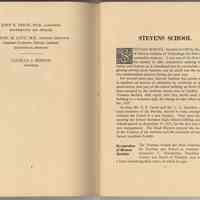

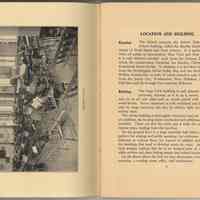

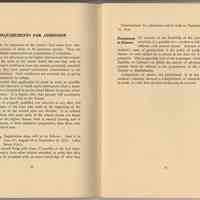
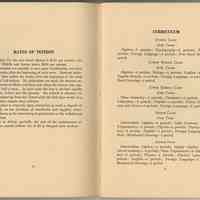
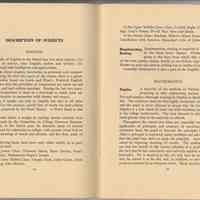

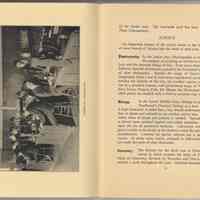
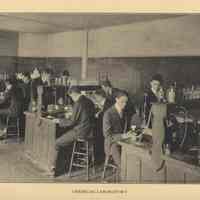
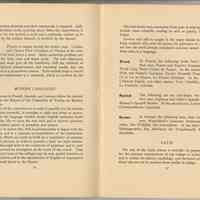

![pp 22-23 Faculty [biography]](https://d3f1jyudfg58oi.cloudfront.net/11047/image/674e4960-fb51-11ed-a641-b3912f9925a9-uFjul7g.tn.jpg)
![pp 24-25 General Information (Sessions [class hours / periods]; Assembly)](https://d3f1jyudfg58oi.cloudfront.net/11047/image/68812410-fb51-11ed-a641-b3912f9925a9-uFjumCt.tn.jpg)
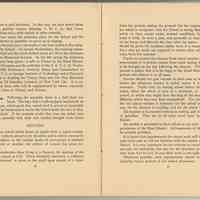
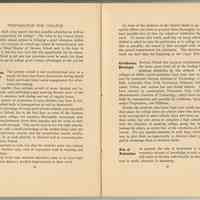
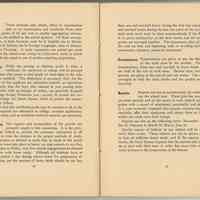
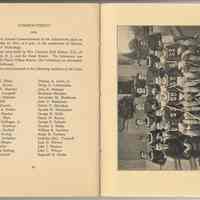
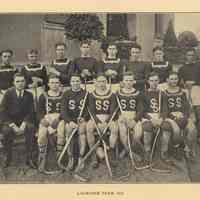
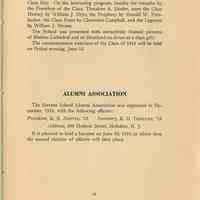
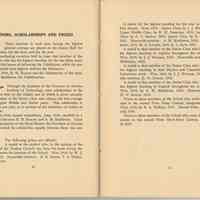
![pp 36-37 Student Activities; Athletics; [School] Paper; Orchestra](https://d3f1jyudfg58oi.cloudfront.net/11047/image/720b9d80-fb51-11ed-a641-b3912f9925a9-uFjuqKx.tn.jpg)
